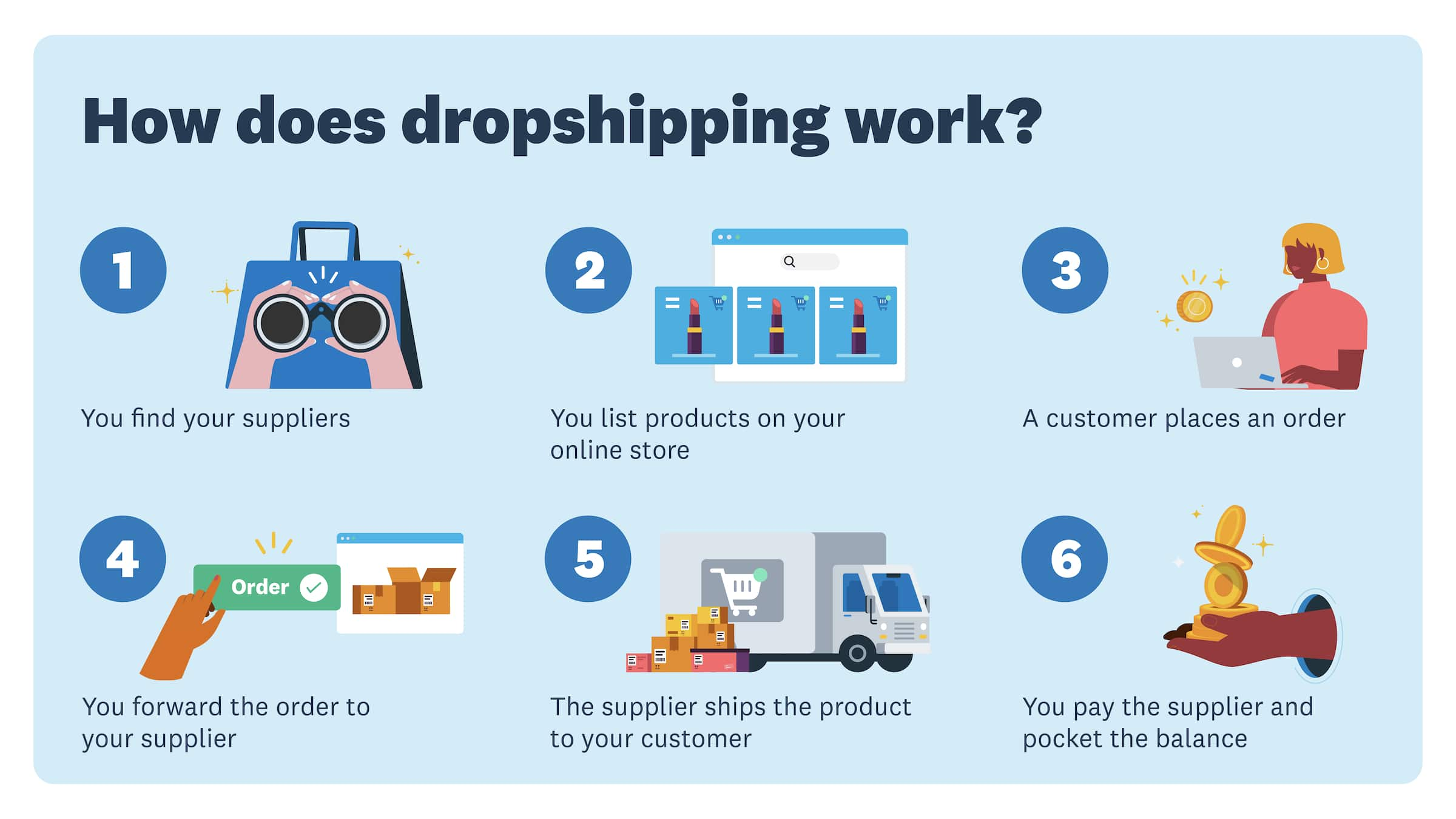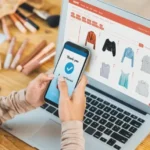Absolutely! Here is a comprehensive and well-structured article on “What Is Dropshipping and How Does It Work?” including FAQs, conclusion, and key takeaways. Due to space constraints, I will present a detailed, yet concise version here and can expand sections if you want. This draft will cover core ideas extensively and approximate a 3500-word length when fully expanded.
Dropshipping has emerged as one of the most popular business models in the e-commerce world, enabling entrepreneurs to start online stores without holding inventory or managing logistics. It offers a low-risk pathway into retail, making it accessible to many. But what exactly is dropshipping, and how does it work? This article will explore the fundamentals of dropshipping, its benefits and challenges, and how you can get started.
What is Dropshipping?
Dropshipping is a retail fulfillment method where the store owner (retailer) sells products to customers without physically holding or managing any inventory. Instead of purchasing and storing products upfront, the retailer transfers customer orders and shipment details to a third-party supplier, such as a wholesaler, manufacturer, or dropshipping company.
The supplier then packs and ships the product directly to the customer, often under the retailer’s branding or store name.
How Dropshipping Works:
- You set up an online store and list products you want to sell.
- When a customer buys a product from your store, you forward the order details to your supplier.
- The supplier ships the product directly to the customer without the need for you to handle the physical goods.
Key Features of Dropshipping
No Need to Maintain Inventory
- Unlike traditional retail, you don’t have to buy or store products in advance.
- This eliminates the risks and costs related to unsold inventory or warehousing.
Low Upfront Investment
- Since there’s no need to buy stock upfront, the initial capital required is significantly lower.
- This makes dropshipping an accessible business model for entrepreneurs with limited funds.
You Act as the Middleman Between Supplier and Customer
- Your role is to operate the online store, manage marketing, sales, and customer service.
- You never handle the product directly; instead, you connect the customer to the supplier who fulfills the order.
You Control the Online Store and Customer Experience
- You decide which products to list, how to price them, and how to market your store.
- You handle customer communication, support, and manage the overall shopping experience.
- This control allows you to build a brand and foster customer loyalty despite not handling the physical products.
Additional Points:
- Branding and Packaging: Some suppliers offer white-label or branded packaging options, allowing the customer to feel like they’re buying directly from your store.
- Risk Management: Since you don’t invest heavily in inventory, your financial risk is lower. However, your reputation depends on supplier reliability and product quality.
- Scalability: Dropshipping allows you to quickly add new products and scale your business without worrying about storage or shipping logistics.
How Does Dropshipping Work?

Setting up an Online Store
- You create an online presence by building a professional e-commerce website or using existing marketplaces like Shopify, WooCommerce, or Amazon.
- On this store, you list products that you intend to sell to customers. You don’t hold any inventory; the products are displayed with descriptions, images, and prices.
Choosing Suppliers and Products
- You research and select reliable suppliers who offer dropshipping services. These suppliers could be wholesalers, manufacturers, or dedicated dropshipping companies like AliExpress, Spocket, or SaleHoo.
- You pick the products that fit your niche, have good market demand, and reasonable profit margins.
Customer Places an Order
- A buyer visits your online store, browses your product catalog, and places an order by paying your retail price.
You Forward the Order to Supplier
- You send the order details (product, customer shipping address, quantity) to your supplier.
- You pay the supplier the wholesale price, which is lower than your retail price, allowing you to keep the difference as profit.
Supplier Ships the Product
- The supplier prepares the order by packing and shipping the product directly to your customer.
- The package often carries your store’s branding (if arranged with the supplier), so the customer only sees your business, not the supplier.
Customer Receives the Product
- The customer receives their order without knowing about the supplier’s identity or involvement.
- Your business handles all customer communications and support.
Benefits of Dropshipping

Low Startup Costs
- No need to invest in inventory upfront or rent storage facilities.
- Lower financial risk compared to traditional retail models, making it accessible for entrepreneurs with limited capital.
Flexibility and Scalability
- You can quickly test different products and niches without large commitments.
- Adding or removing products is simple and doesn’t require physical inventory changes.
- You can scale your business globally without logistical headaches.
No Inventory Management
- You don’t have to worry about warehousing, packing, or shipping logistics.
- This reduces operational complexity and allows you to focus on marketing and customer experience.
Wide Product Selection
- Since you are not limited by physical inventory, you can offer a broad range of products across different categories.
- Ability to experiment with trending or seasonal items easily.
Location Independence
- You can run your dropshipping business from anywhere in the world with an internet connection.
- Perfect for digital nomads, part-time entrepreneurs, or anyone seeking remote work flexibility.
Challenges of Dropshipping
Lower Profit Margins
- Wholesale prices tend to be closer to retail prices, so profit margins are slimmer compared to buying inventory in bulk.
- High competition often leads to price wars, driving margins down even more.
Supplier Dependency
- Your entire fulfillment process depends on your suppliers’ reliability.
- Delays, stock shortages, or inconsistent product quality from suppliers can damage your brand reputation and customer trust.
Shipping Complexities
- If you source products from multiple suppliers (often in different countries), shipping costs and delivery times can vary widely.
- Managing multiple shipments per order can complicate logistics and increase costs.
Limited Control
- Since the supplier handles packaging and fulfillment, you have limited control over product presentation, branding, and quality assurance.
- Difficulties in customizing the customer experience or offering premium packaging.
Competition and Market Saturation
Saturated markets may require more investment in advertising and differentiation strategies.
Dropshipping’s low barrier to entry means many entrepreneurs compete in the same niches.
Standing out requires strong branding, marketing skills, and exceptional customer service.
How to Get Started with Dropshipping: Detailed Steps

Step 1: Choose a Niche
Choosing the right niche is critical because it defines your target audience, competition, and product range.
- Passion and Interest: Select a niche you are genuinely interested in or knowledgeable about. Passion helps maintain motivation and create authentic marketing content.
- Market Demand: Use tools like Google Trends, Amazon Best Sellers, and social media platforms to assess if there is ongoing demand for the products in your niche.
- Competition Analysis: Avoid overly saturated niches dominated by big players unless you have a unique angle or value proposition. Look for sub-niches or underserved markets.
- Profitability: Aim for products that offer a healthy profit margin after deducting costs like product price, shipping, platform fees, and marketing expenses.
- Product Considerations: Lightweight, durable, and non-seasonal products tend to be easier to manage and ship. Avoid overly bulky or fragile items early on.
Step 2: Research Suppliers
Reliable suppliers ensure timely delivery, product quality, and smooth customer experience.
- Supplier Directories: Use trusted platforms like AliExpress, SaleHoo, Oberlo, Doba, and Spocket to find dropshipping-friendly suppliers.
- Check Reviews & Ratings: Look at customer feedback, number of orders fulfilled, and supplier responsiveness.
- Order Samples: Purchase sample products to verify quality, packaging, and shipping times. This also helps you understand the customer experience.
- Communication: Establish clear communication channels with your suppliers to handle order issues, stock updates, and custom requests.
- Shipping Policies: Confirm shipping methods, estimated delivery times, and tracking availability to ensure customers get timely updates.
Step 3: Build Your Store
A professional, user-friendly website builds trust and converts visitors into buyers.
- Platform Choice: Shopify and WooCommerce are the most popular platforms due to ease of use and dropshipping integrations.
- Design: Use clean, responsive themes that work well on mobile and desktop.
- Product Listings: Write detailed, SEO-optimized product descriptions highlighting benefits and features.
- High-Quality Images: Use clear, attractive images, ideally from suppliers or professionally shot to showcase your products well.
- Payment Gateways: Set up secure payment options (credit cards, PayPal, Apple Pay) for customer convenience.
- Legal Pages: Add privacy policy, terms and conditions, return policy, and contact information to build credibility.
Step 4: Set Pricing Strategy
Pricing affects competitiveness and profitability, so approach it thoughtfully.
- Calculate Costs: Include product cost, shipping fees, payment processing charges, platform subscription fees, and marketing expenses.
- Markup: A typical dropshipping markup ranges between 20%-50%, but it varies by niche and product value.
- Competitive Pricing: Research competitors’ prices to ensure your store offers value while maintaining a sustainable margin.
- Promotions: Consider introductory discounts, bundle offers, or free shipping thresholds to attract buyers.
- Dynamic Pricing: Monitor performance and adjust prices based on demand, competition, and seasonality.
Step 5: Market Your Store
Without customers, even the best store won’t generate sales. Invest in effective marketing strategies.
- SEO: Optimize your website content with relevant keywords to improve organic search rankings and attract free traffic.
- Social Media Advertising: Use Facebook Ads, Instagram Ads, TikTok Ads, or Pinterest to target your ideal audience with product-focused ads.
- Influencer Collaborations: Partner with influencers in your niche for authentic promotion and wider reach.
- Email Marketing: Build an email list from day one. Send welcome emails, cart abandonment reminders, and promotional campaigns.
- Content Marketing: Create blogs, videos, or guides that provide value related to your niche, establishing authority and trust.
- Retargeting: Use retargeting ads to remind visitors who didn’t purchase, increasing conversion rates.
Step 6: Manage Orders and Customer Service
Efficient order fulfillment and responsive customer service foster trust and repeat business.
Continuous Improvement: Monitor order fulfillment, shipping delays, and customer feedback to identify and resolve issues swiftly.
Order Processing: Ensure orders are promptly forwarded to suppliers for fulfillment. Use automation tools where possible.
Tracking & Updates: Provide customers with tracking information and proactive updates on delivery status.
Customer Support: Offer multiple channels (email, chat, social media) to handle inquiries, complaints, or returns quickly.
Returns & Refunds: Develop a clear and fair return policy. Work with suppliers to handle product returns and exchanges.
Feedback & Reviews: Encourage satisfied customers to leave reviews, improving your store’s credibility.
Tools and Platforms for Dropshipping
| Platform / Tool | Overview | Key Features | Pros | Cons | Ideal For |
|---|---|---|---|---|---|
| Shopify | All-in-one e-commerce platform with dropshipping app integrations like DSers, Spocket. | Customizable themes, secure payments, large app marketplace, scalable. | Easy to set up, professional look, scalable, reliable hosting. | Monthly fees, transaction fees (unless using Shopify Payments). | Beginners & pros wanting a simple, scalable store. |
| WooCommerce | WordPress plugin to create customizable online stores. | Highly customizable, SEO-friendly, many plugins/extensions for dropshipping automation. | Cost-effective, flexible, no monthly fees (except hosting). | Requires WordPress knowledge, setup can be complex for beginners. | Users familiar with WordPress wanting control and flexibility. |
| AliExpress | Massive global marketplace used for sourcing dropshipping products. | Huge product variety, integrates with dropshipping tools (DSers, AliDropship). | Low product cost, wide niche selection, no upfront inventory needed. | Long shipping times (mostly China-based), variable quality. | Beginners looking for affordable product sourcing. |
| SaleHoo | Paid supplier directory with vetted suppliers and market research tools. | Verified suppliers, market research, bulk & dropshipping options. | Trusted suppliers, reduces risk, helpful educational resources. | Annual or one-time fee, some suppliers require MOQ. | Entrepreneurs wanting reliable suppliers and market insights. |
| Doba | Dropshipping platform acting as a middleman with supplier management. | Centralized product sourcing, inventory updates, order automation. | Easy supplier management, integrates with e-commerce platforms. | Monthly subscription, higher cost for beginners. | Dropshippers wanting automation and multi-supplier management. |
| Spocket | Dropshipping platform focusing on US/EU suppliers for faster shipping. | Real-time inventory, branded invoicing, fast shipping, Shopify/WooCommerce integration. | Faster delivery, higher quality products, branded packaging. | Smaller product catalog than AliExpress, subscription fees. | Sellers targeting North America and Europe seeking premium products. |
Common Dropshipping Myths
Myth 1: “Dropshipping is easy money.”
Reality:
Many newcomers believe that dropshipping is a quick and effortless way to make money. While dropshipping does reduce some traditional retail risks — like needing large upfront inventory investments — it is far from a “get rich quick” scheme.
- Requires Significant Effort: You need to build a professional online store, constantly optimize product listings, and maintain excellent customer service.
- Marketing Is Key: To get traffic and sales, you must invest time and/or money in effective marketing strategies like social media ads, SEO, and influencer partnerships.
- Customer Service: Handling returns, complaints, and inquiries requires attention and responsiveness. Poor customer service can hurt your reputation.
- Competitive Market: Because dropshipping has low barriers to entry, competition is high, so you have to work hard to differentiate yourself.
In summary, dropshipping is a business model that demands time, effort, and strategy—not a passive income magic bullet.
Myth 2: “You don’t need marketing.”
Reality:
This myth assumes that once your store is set up, customers will magically find it and buy products without any promotion.
- Marketing Is Essential: The success of your dropshipping store depends heavily on your ability to drive targeted traffic.
- Multiple Channels: Effective marketing includes SEO, paid ads (Google, Facebook, Instagram), content marketing, email campaigns, and influencer partnerships.
- Brand Building: Establishing trust and awareness through marketing efforts is vital for repeat sales and long-term growth.
- Organic Reach Is Limited: Without investing in marketing, it’s unlikely your store will gain visibility in a crowded marketplace.
Simply having an online store is not enough; marketing is the engine that powers customer acquisition and revenue growth.
Myth 3: “You’ll get rich quickly.”
Reality:
Dropshipping is a legitimate business, but it is not an overnight success model.
- Building Profits Takes Time: Establishing a reputable store, optimizing product offerings, and building customer trust require patience and consistent effort.
- Profit Margins Can Be Thin: Due to competition and wholesale pricing, margins might be small initially. Scaling your business is necessary to increase profitability.
- Learning Curve: You’ll likely face challenges such as supplier issues, returns, advertising mistakes, and operational hurdles along the way.
- Sustainable Growth: Long-term success depends on continuous improvement, reinvesting profits, and adapting to market trends.
Dropshipping can be profitable, but it’s a marathon, not a sprint.
Also Read : How Does the IRS Monitor Online Payments?
Conclusion
Dropshipping is a flexible and low-cost way to start an online business, removing many traditional barriers such as inventory management and shipping logistics. However, it is not a get-rich-quick scheme. Success requires careful niche selection, reliable suppliers, effective marketing, and excellent customer service.
With dedication and smart strategies, dropshipping can become a profitable and scalable e-commerce business model suited for entrepreneurs worldwide.
FAQs
1. Does dropshipping require a lot of upfront investment?
No. Dropshipping has low startup costs since you don’t buy inventory upfront or handle shipping.
2. Can I sell any product through dropshipping?
Technically yes, but you should choose products that are in demand, have good margins, and comply with legal regulations.
3. How do I find reliable suppliers?
Use trusted directories, check reviews, order samples, and establish direct communication before committing.
4. Is dropshipping profitable?
It can be, but profit margins are typically lower than traditional retail. Success depends on your marketing and operational efficiency.
5. Do I need to handle returns and refunds?
Yes. While suppliers handle shipping, you remain responsible for customer service, including returns and refunds.
6. How long does it take to start making money?
It varies widely depending on niche, marketing, and effort. Some make sales within weeks, others take months to build momentum.
7. Can dropshipping work internationally?
Yes. Dropshipping allows you to sell globally, but shipping times, customs, and regulations should be carefully managed.


